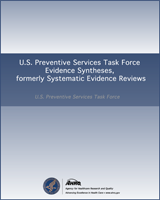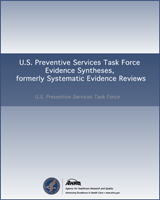NCBI Bookshelf. A service of the National Library of Medicine, National Institutes of Health.
Hillier TA, Vesco KK, Whitlock EP, et al. Screening for Gestational Diabetes Mellitus [Internet]. Rockville (MD): Agency for Healthcare Research and Quality (US); 2008 May. (Evidence Syntheses, No. 60.)
This publication is provided for historical reference only and the information may be out of date.
Condition Definition/Burden of Disease
Gestational diabetes mellitus (GDM) is currently defined as any degree of glucose intolerance with onset or first recognition during pregnancy.1–3 This definition does not exclude glucose intolerance that may have antedated pregnancy. Currently, the prevalence of GDM in the US ranges from 1 to 14 percent, depending on the characteristics of the population screened.1,4
A major challenge in evaluating the evidence on GDM screening and treatment is the range of adverse maternal and neonatal outcomes associated with untreated GDM. In 2003, the United States Preventive Services Task Force (USPSTF) reviewed the evidence on health outcomes associated with untreated GDM5 and found that the pregnancies of women with GDM were associated with a higher percentage of fetal macrosomia, brachial plexus injury, clavicular fracture, and neonatal hypoglycemia. Data were mixed on the association between GDM and increased perinatal mortality. Older data demonstrated an increased risk of perinatal mortality in women with GDM, but more recent studies did not.5,6 This discrepancy may reflect the rarity of perinatal mortality events and/or that improvements in obstetrical and neonatal practices have concurrently changed during the past 40 years, resulting in reduced adverse maternal and neonatal outcomes. The USPSTF also found the evidence was too limited at that time to determine whether GDM is associated with increased rates of neonatal hypoglycemia, preterm birth, hyperbilirubinemia, hypocalcemia, polycythemia, or long-term implications for the offspring such as an increased risk of impaired glucose tolerance, childhood obesity, and neuropsychological disturbance. Although women with GDM have been demonstrated to have a higher rate of cesarean section and a higher risk of developing type 2 diabetes mellitus, data were limited on other maternal health outcomes, such as a higher rate of pre-eclampsia or third- and fourth-degree perineal lacerations from vaginal delivery.5 The 2003 USPSTF evidence review suggested that hyperglycemia's impact on adverse maternal and neonatal outcomes is probably continuous. The evidence, however, was insufficient “to determine the magnitude of health benefit for any treatment among the large number of women with GDM at milder degrees of hyperglycemia.”5
Risk Assessment
While previous reviews were not conclusive as to the benefits of either a universal or risk-based screening program for GDM,5,6 risk-factor assessment has played a prominent role in GDM screening in the US. Currently, the American Diabetes Association (ADA) states that low-risk women need not be screened and the American College of Obstetrics and Gynecology (ACOG) states that low-risk women may be less likely to benefit from screening.1,2 ADA and ACOG consider a woman to be at low risk for GDM if she meets all of the following criteria: (1) younger than age 25; (2) not a member of an ethnic group with increased risk for developing type 2 diabetes; (3) body mass index of 25 or less; (4) no previous history of abnormal glucose tolerance or adverse obstetrics outcomes usually associated with GDM; and (5) no known history of diabetes in a first-degree relative.
Traditionally, women considered to be at higher risk for GDM are those who are obese, have previously delivered a macrosomic infant, have a family or personal history of diabetes, or have had a previous adverse pregnancy outcome.2,7 As obesity and diabetes mellitus have become more prevalent in US women of child-bearing age,8 so has gestational diabetes.9,10 One in five (22 percent) of US women age 20 to 39 are now estimated to be obese (BMI ≥30 kg/m2).11 One US study performed in Colorado found GDM prevalence doubled during the past decade, from 2.1 to 4.1 percent between 1994 - 2002.9 In 2002, the age-adjusted prevalence of GDM was 3.1 percent in non-Hispanic whites, 5.4 percent in Hispanics, 5.5 percent in African-Americans, and 6.8 percent in Asians. In a second study performed in Northern California, the age- and race/ethnicity-adjusted cumulative incidence rate of GDM increased from 5.1 to 6.9 percent between 1991 and 2000.10 In 2000, the yearly age-adjusted cumulative incidence of GDM was 5.7 percent in Whites, 6.4 percent in African-Americans, 8.3 percent in Hispanics, and 9.7 percent in Asians. Among Americans Indians in North Dakota and Montana, a review of birth records revealed that the rate of any type of diabetes (pre-gestational or gestational) increased in Montana from 31 to 41 per 1,000 births (p=0.04) from 1989-1991 to 1998-2000 and increased from 38 to 48 per 1,000 births (p=0.06) in North Dakota.12 Increasing rates of obesity in the general population likely contributes to the increasing prevalence of GDM, it is not clear how this increasing obesity will affect the relative proportion of women with GDM with pre-existing (but unrecognized) type 2 diabetes, versus a transient worsening of glucose intolerance in pregnancy (both classified as GDM), as obesity is a risk factor for these two distinct entities that comprise GDM.
Risk factor based screening for GDM is the current practice in most of Europe and outside of the US, and screening rates with blood glucose testing based on provider surveys ranges from 18 to 37 percent of pregnancies.13–16 A postal survey in Australia in 360 of 544 hospitals surveyed found that screening for GDM was undertaken by 284 (87 percent) of hospitals and of these, 151 (53 percent) screened all women and 63 (22 percent) selectively screened women.17 In the US, universal screening is still the most common screening practice. In 2004, Gabbe and colleagues and reported in 569/1,398 ACOG fellows and Junior fellows surveyed (41 percent response rate), and found that 96 percent of obstetricians routinely screen for GDM, nearly all by using a 50-g GCT.18
Current Practice
Gestational diabetes is currently diagnosed using either a one- or two-step method. In the one-step method, a 75 g or 100 g oral glucose load is administered in a fasting state without prior plasma or serum screening.1 Plasma glucose levels are evaluated fasting and 1 and 2 hours after the 75 g load, or fasting and 1, 2, and 3 hours after the 100 g glucose load. The two-step method involves an initial screening test, a 50 g oral glucose challenge test (GCT), followed by either a 75 g or 100 g oral glucose tolerance test (OGTT), if the screening test is abnormal.
Outside the US, the one-step 75 g OGTT is most common.19 The two-step method (GCT, then OGTT), however, is the currently preferred screening method in the US.1,2 The GCT screening test comprises a 50 g glucose load, which is administered without regard to fasting state, followed 1 hour later by assessment of the plasma or serum glucose level.1,2 The two commonly used threshold values for a positive test are >130 mg/dl (7.2 mmol/l) or >140 mg/dl (7.8 mmol/l). The sensitivity of the GCT varies by threshold value and the population's characteristics.1,20,21
Various diagnostic criteria exist for the 75 g and 100 g OGTT (Table 1). Currently, the ADA recommends the use of the Carpenter and Coustan diagnostic criteria irrespective of the glucose load.1 ACOG recommends the 100 g test with use of either the Carpenter and Coustan (C&C) or the National Diabetes Data Group (NDDG) criteria.2 The World Health Organization (WHO) recommends the one-step 75 g OGTT and has established threshold values that differ from those recommended by Carpenter and Coustan.19
Screening for GDM usually occurs between 24–28 weeks gestation1,2,5 because insulin resistance increases during the second trimester, and glucose levels will rise in women who do not have the ability to produce enough insulin to adapt to this resistance.22–24 Laboratory studies show that insulin secretion increases in response to an intravenous glucose challenge with advancing gestation (i.e., as women become more insulin resistant, more insulin is needed to metabolize the same stimulus).22 Early pregnancy is associated with increased insulin sensitivity, however, and in a normal pregnancy fasting glucose values are lower during the first trimester and early second trimester, compared to the non-pregnant state.22–25 This increased insulin sensitivity is also manifest in women with pre-existing (pre-gestational) diabetes who have decreasing insulin requirements early in gestation.22 While the ideal timing for screening the average-risk woman might be after 24 weeks gestation when insulin resistance is increasing, early screening may benefit high-risk women in order to detect previously unrecognized type 2 diabetes. While it is unclear which screening methodology would be most appropriate in this setting, the current ADA recommendations for the diagnosis of diabetes mellitus include the use of fasting plasma glucose levels.1 Diabetes mellitus is diagnosed if fasting plasma glucose concentrations are 126 mg/dl or greater on two or more occasions. In a cohort of 4180 pregnancies with gestational (n=3764) or type 2 (n=416) diabetes, fasting glucose levels above 120 mg/dl at entry into prenatal care were associated with an increased prevalence of major congenital abnormalities (7.3 percent) compared with pregnant women with lower fasting glucose levels (2.1 percent); these major congenital abnormalities were in the same organ systems that have been previously described in pregnancies complicated by type 1 diabetes.26
Clinical efforts for optimizing maternal glucose control in women with pre-gestational diabetes have been associated with a decreased risk of perinatal death.22 Uncontrolled pre-gestational diabetes has been associated with an increased risk of congenital malformations, spontaneous abortion, fetal macrosomia, and neonatal hypoglycemia, hypocalcemia, and hyperbilirubinemia.22 Perinatal mortality rates and congenital malformations among pregnant women with type 2 diabetes may be as high as those observed in women with type 1 diabetes.27,28 Diagnosis of previously unrecognized type 2 diabetes early in pregnancy, also defined as GDM, could potentially provide an opportunity to impact these outcomes.
The ADA currently recommends screening high-risk pregnant women (marked obesity, personal history of GDM, glycosuria, or a strong family history of diabetes) at the first antenatal visit.1 Without making a formal recommendation, ACOG suggests that women with a history of GDM in a previous pregnancy may benefit from early diagnosis in a subsequent pregnancy.2
These differing criteria used in clinical practice result in differing prevalences of women diagnosed with GDM and create a conundrum in reviewing the evidence, as there is no single accepted method for screening or diagnosis of GDM. The multiplicity of accepted screening criteria in use is largely a reflection of lack of available evidence demonstrating a benefit of specified health outcomes with any of the national or international standard screening criteria.
Previous USPSTF Recommendation
In 2003, the USPSTF concluded that the scientific evidence was insufficient to advise for or against routine screening of GDM in all pregnant women. They found fair-to-good evidence that screening combined with therapy for GDM can reduce the rate of fetal macrosomia, but were unable to find sufficient evidence that GDM screening reduced adverse health outcomes for mothers or their infants.5
With the increasing prevalence of US women at high risk for type 2 diabetes and GDM, the issue of early screening is becoming increasingly important. The previous USPSTF review did not include evidence related to GDM screening prior to 24 weeks gestation. This review considered all evidence from the previous review and identified and evaluated new evidence since the prior review on the risks and benefits of GDM screening at 24 weeks or later. In addition, we newly reviewed all of the available evidence pertaining to GDM screening prior to 24 weeks.
- Introduction - Screening for Gestational Diabetes MellitusIntroduction - Screening for Gestational Diabetes Mellitus
Your browsing activity is empty.
Activity recording is turned off.
See more...

